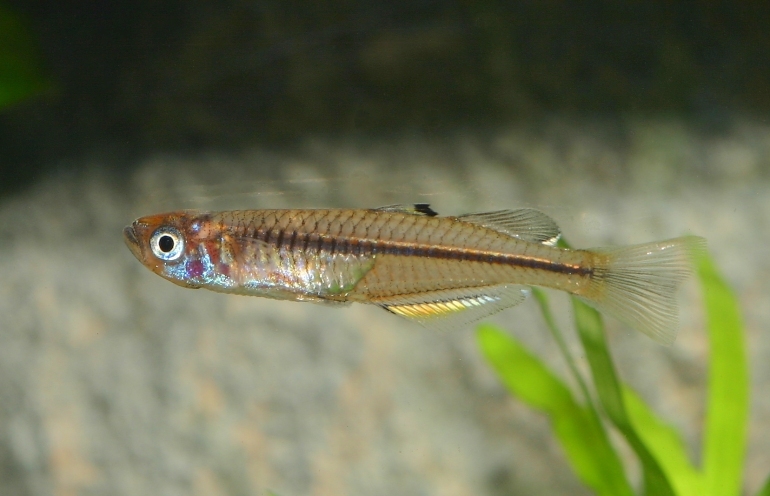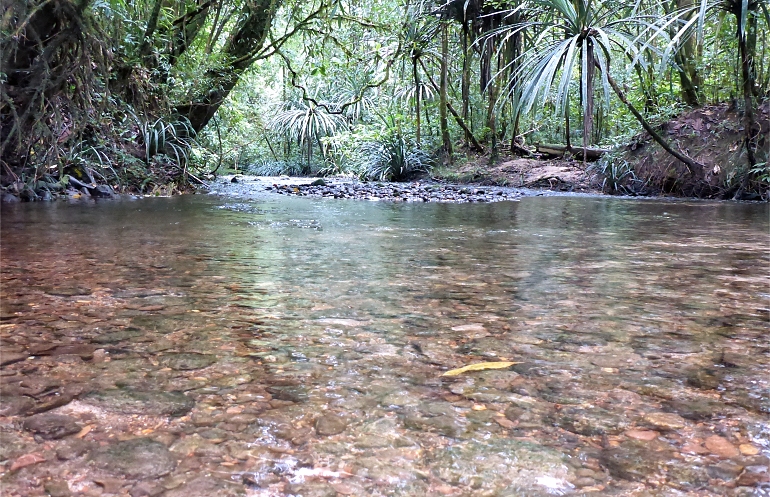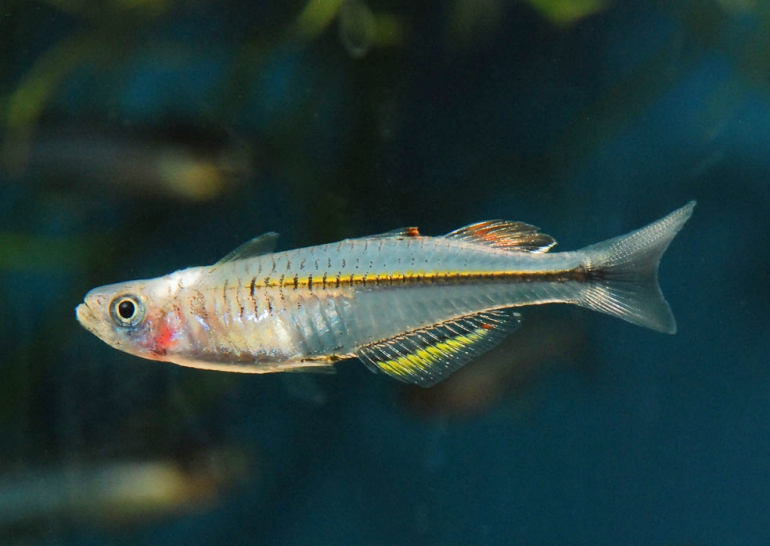|
 |
Pseudomugil pellucidus - photo© Hans Herbert Boeck |
Allen, Ivantsoff, Shepherd and Renyaan, 1998
Transparent Blue-eye
Species Summary
Pseudomugil pellucidus was described on the basis of 30 specimens collected from tributaries of the Iwaka and Kopi rivers in the vicinity of Tembagapura, West Papua. The species is very closely related to Pseudomugil novaeguineae but is distinct from the latter on the basis of greater number and length of first dorsal fin spines, number of anal rays, shape of vomer, basibranchials, pectoral girdle, urohyal, and anal pterygiophores. Pseudomugil pellucidus is also different in colouration. It was named "pellucidus" (Latin), meaning clear or transparent.
Pseudomugil pellucidus is a small slender-bodied species, usually not exceeding 35 mm in length. The head is silver-reddish blending into a silver-reddish opercle and peritoneum. The rest of the body is quite transparent. The swim bladder is transparent and obvious. The upper edge of midlateral band is neon-red, while the rest of band is solid black, extending to the hypural joint and then fanning out onto the caudal as thin black stripes on each of the mid-caudal rays. The first dorsal fin is jet-black, with a small flash of orange on the first dorsal spine. The second dorsal fin is dusky with rays suffused with melanophores to form black stripes; posteriorly edged with brilliant orange. Thin black and orange bands extend along entire length of the anal fin. The upper half of caudal has small flashes of orange. The edges of the body scales are outlined heavily in black above the midlateral band and lightly below. The iris has an orange hue. Individuals possess a pupil-sized white spot on top of the head which is readily visible when observed from the stream bank. Reddish coloured eggs are laid by Pseudomugil pellucidus.
 |
Mimika River habitat - photo© Andreas Wagnitz |
Distribution & Habitat
Pseudomugil pellucidus have been collected from tributaries of the Mimika, Iwaka and Kopi Rivers in the Timika-Tembagapura region of West Papua. They are generally found in small shallow streams usually slow flowing through dense rainforest, always in clear water which may be deeply stained with tannin. Aquatic vegetation was sparse or absent at the collection sites. Bottom is variable from sand, to gravel, pebble and rocks. Water temperature 24-28°C, pH 6.7-7.8. Pseudomugil pellucidus swims close to the surface, in contrast with its sympatric congener, Pseudomugil ivantsoffi which is found in mid-water or near the bottom. Other fishes collected from these habitats include Pseudomugil ivantsoffi, Pseudomugil novaeguineae, Melanotaenia goldiei, Melanotaenia rubrostriata, and Melanotaenia ogilbyi.
The Timika region includes the following rivers: Kamora River catchment (Kamora, Tuaba, Wataikwa, Iwaka) Wania River Catchment (Wania) Tipuka River Catchment (Tipuka) Ajkwa River Catchment (Ajkwa) Minajerwi River Catchment (Minajerwi, Kopi, Aimua) Mawati River Catchment (Mawati) Otokwa River Catchment (Otokwa) Mamoa River Catchment (Mamoa, Seruka) Atuka River Catchment (Atuka, Wapuka) [The Atuka River meanders north to its junction with the Kamora River, very close to the village of Mioko.] Blackwater steams' dark colouration is due to the presence of organic substances which drain heath forests. This black or tea-toned colouration (these rivers are called kali kopi in Indonesian, or coffee stream - kali is Indonesian for river) is quite common in the area, due to extensive heath forest. These streams start in the heath and are shorter and narrower than the rivers which begin in the mountains and have enough volume from rainfall to dissolve the colouration. The blackwater streams all drain into the rivers.
 |
Pseudomugil pellucidus - photo© Hans Booij |
Remarks
Live specimens were collected for the aquarium hobby in 1999 by Heiko Bleher. In 2004, Iain Wilson and Charles Nishihira collected live specimens of this species from Kali Iwaka (Deky Creek) and Kali Kopi, along with specimens of Pseudomugil novaeguineae, Pseudomugil ivantsoffi, Melanotaenia goldiei and Melanotaenia rubrostriata. During the 2004 collection a new colour variety of Pseudomugil pellucidus was collected from Kali Meyon. Males have spotted red and black on the dorsal fin. The anal fin colouration was also different with lots of yellow. Two streams were collected that are only about 15 metres apart and intersect about 150 meters downstream and each stream contained a different colour variation. A yellow-coloured form of Melanotaenia rubrostriata was also found. Although a very attractive species if kept under suitable conditions, Pseudomugil pellucidus are rarely seen in the retail aquarium trade and are mainly kept by a few aquarists who are principally interested in Australian and New Guinea fishes.
.jpg) |
Pseudomugil pellucidus Mimika River - photo© Andreas Wagnitz |
Literature
Allen G.R., W. Ivantsoff, M.A. Shepherd and S. J. Renyaan (1998) Pseudomugil pellucidus (Pisces: Pseudomugilidae), a newly discovered blue-eye from Timika-Tembagapura region, Irian Jaya. Aqua Journal of Ichthyology and Aquatic Biology, 3(1):1-8.
Allen G.R., K. Hortle and S. Renyaan (2000) Freshwater Fishes of the Timika Region, New Guinea. P.T. Freeport Indonesia, Timika, Indonesia.
Ivantsoff W., Aarn, M.A. Shepherd and G.R. Allen (1997) Pseudomugil reticulatus (Pisces: Pseudomugilidae), a review of the species described from a single specimen from Vogelkop Peninsula, Irian Jaya, with further evaluation of the systematics of Atherinoidea. Aqua Journal of Ichthyology and Aquatic Biology, 2(4):53-64.
Muller K (2004) Biodiversity of New Guinea [unpublished document]
Adrian R. Tappin
Updated July, 2019



|
|

